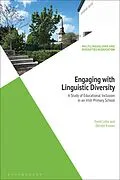Engaging with Linguistic Diversity describes an innovative and highly successful approach to inclusive plurilingual education at primary level. The approach was developed by Scoil Bhríde (Cailíní), Blanchardstown, as a way of converting extreme linguistic diversity - more than 50 home languages in a school of 320 pupils - into educational capital. The central feature of the approach is the inclusion of home languages in classroom communication. After describing the national context, the book traces the development of Scoil Bhríde's approach and explores in detail its impact on classroom discourse, pupils' plurilingual literacy development, and their capacity for autonomous learning. The authors illustrate their arguments with a wealth of practical evidence drawn from a variety of sources; pupils' and teachers' voices are especially prominent. The concluding chapter considers issues of sustainability and replication and the implications of the approach for teacher education. The book refers to a wide range of relevant research findings and theories, including translanguaging, plurilingual and intercultural education, language awareness and language learner autonomy. It is essential reading for researchers and policy-makers in the field of linguistically inclusive education.
Autorentext
David Little was formerly Director of the Centre for Language and Communication Studies and Head of the School of Linguistic, Speech and Communication Sciences at Trinity College Dublin, Ireland. For the past ten years, he has played a leading role in the Council of Europe's work on the language education of migrants.
Klappentext
Engaging with Linguistic Diversity describes an innovative and highly successful approach to inclusive plurilingual education at primary level. The approach was developed by Scoil Bhríde (Cailíní), Blanchardstown, as a way of converting extreme linguistic diversity - more than 50 home languages in a school of 320 pupils - into educational capital. The central feature of the approach is the inclusion of home languages in classroom communication.
After describing the national context, the book traces the development of Scoil Bhríde's approach and explores in detail its impact on classroom discourse, pupils' plurilingual literacy development, and their capacity for autonomous learning. The authors illustrate their arguments with a wealth of practical evidence drawn from a variety of sources; pupils' and teachers' voices are especially prominent. The concluding chapter considers issues of sustainability and replication and the implications of the approach for teacher education.
The book refers to a wide range of relevant research findings and theories, including translanguaging, plurilingual and intercultural education, language awareness and language learner autonomy. It is essential reading for researchers and policy-makers in the field of linguistically inclusive education.
Inhalt
Preface
Series Editors' Foreword
Foreword, Jim Cummins (University of Toronto, Canada)
Introduction
1. The National Context
2. Scoil Bhríde (Cailíní) and the Evolution of an Inclusive Language Education Policy
3. Languages in Classroom Discourse: Using Plurilingual Skills to Construct Knowledge
4. The Development of Plurilingual Literacy
5. Plurilingual Learning and the Development of Learner Autonomy
6. Implications and Consequences
Appendix
Scoil Bhríde's (Cailíní)'s Language Policy Statement
References
Index
